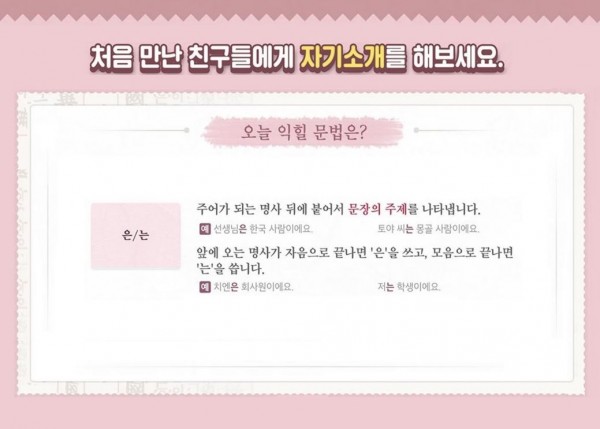한국어 문법 (Korean grammar) - 은/는
도우미
본문
처음 만난 친구들에게 자기소개를 해보세요.
Introduce yourself to your first-time friends.
- 오늘 익힐 문법은?
- What grammar will you learn today?
은/는 (eun/neun)
주어가 되는 명사 뒤에 붙어서 문장의 주제를 나타냅니다.
It is attached after the subject noun to indicate the subject of the sentence.
예) 선생님[은] 한국 사람이에요. (The teacher is Korean.)
토야 씨[는] 몽골 사람이에요. (Mr. Toya is from Mongolia.)
앞에 오는 명사가 자음으로 끝나면 '은'을 쓰고, 모음으로 끝나면 '는'을 씁니다.
If the preceding noun ends with a consonant, write '은(eun)', and if it ends with a vowel, write'는(neun)'.
예) 치엔[은] 회사원이에요. (Chien is an office worker.)
저[는] 학생이에요. (I am a student.)
고맙습니다.
Thank you.
Introduce yourself to your first-time friends.
- 오늘 익힐 문법은?
- What grammar will you learn today?
은/는 (eun/neun)
주어가 되는 명사 뒤에 붙어서 문장의 주제를 나타냅니다.
It is attached after the subject noun to indicate the subject of the sentence.
예) 선생님[은] 한국 사람이에요. (The teacher is Korean.)
토야 씨[는] 몽골 사람이에요. (Mr. Toya is from Mongolia.)
앞에 오는 명사가 자음으로 끝나면 '은'을 쓰고, 모음으로 끝나면 '는'을 씁니다.
If the preceding noun ends with a consonant, write '은(eun)', and if it ends with a vowel, write'는(neun)'.
예) 치엔[은] 회사원이에요. (Chien is an office worker.)
저[는] 학생이에요. (I am a student.)
고맙습니다.
Thank you.
Comments
Nora
It's the most difficult part to learn Korean. Lol
Elin Micas
Thanks for sharing. 고맙습니다.



 Customer Support Center
Customer Support Center